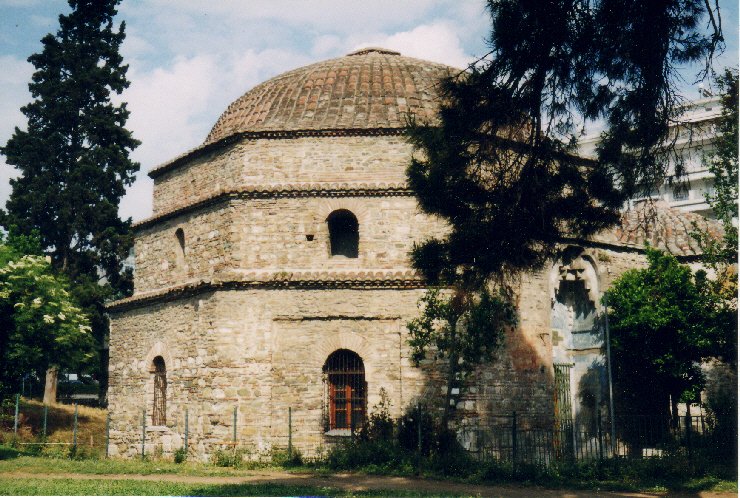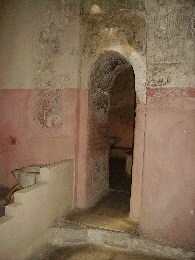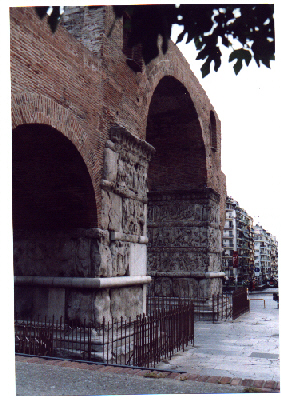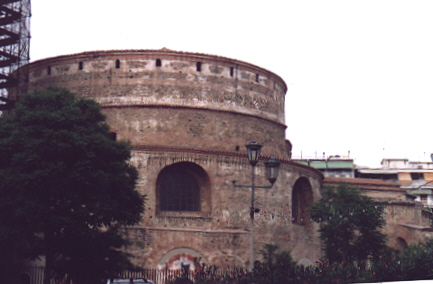|
Thessaloníki
The Main
Sights:
Ancient Agora: in Platía
Dhikastiríon
What
we can see are remains of the Roman Forum built in
the 2nd century AD over the Greek agora. Four columns
without capitals and column bases remain of the double
stoa which ran round three sides of the large paved
square. One complete monolithic Roman column with
Corinthian capital is standing. To make use of the
sloping site the southern stoa was built over a cryptoporticus,
a series of brick arches. There are five
doorways or square arches in front of odeon. The
odeon became a circus. The site is still being excavated
and restored.
Panayía
Halkéon
(the Church of Our Lady of the
Coppersmiths) This little brick church set in a
lovely rose garden is well worth a quick visit. It was
built in 1028 on the site of a temple of Hephaistos and
turned into a mosque in Turkish times so only a few of
the frescoes have survived.
|
 |
Bey Hamam
(Parádhisos Baths)
Egnata/Aristelous open Mon-Fri
0800-1430 entrance free
The first Ottoman bath
house built in Thessaloniki in 1444, and the largest in
Greece, it was in use until 1968. It is a double
bathhouse with separate male and female sections (and
separate entrances).
It
is a little gem of a place, full of arches and niches and
gorgeously decorated walls, floors and ceilings, with two
octagonal rooms; the first has a wonderful painted
dome and a staircase to the wooden upper gallery. Through
arches are small rooms each with four oval marble
basins.
|
 |
|
Modhiáno Market,
named after
the Jewish family is opposite the baths. This
is a typical eastern market with meat (sometimes alive!),
fish and vegetables in abundance as well as almost
anything you could possibly need. I haven't made a note
of opening times but I think it close in the early
afternoon.
The
Hamza Bei mosque was built in 1467, restored after a
fire in 1620. The largest mosque in Greece, more recently
used as the Alkazar cinema.
The
Bezesténi
(just below the junction of
Egnatia and Venizelou) is the old cloth market, built at
the end of the 15th century, and was for a long time the
commercial centre. It is an interesting building with six
domes (originally lined with lead) but the shops inside
are disappointing. There are entrances on each of its
four sides.
The Arch of Galerius
(Kamara) at the junction of Egnatia and Gounari.
Built as a
triumphal arch by Galerius around AD 305 to celebrate his
victories over the Persians in 297. It formed part of a
grandiose complex of buildings including the Palace, the
Hippodrome and the Rotonda. (It stretches now from
Odos Tsimski, across Nikolaou and Egnatia up to the
Rotonda)
Very
little now remains of this elaborate structure,
originally it had two sets of parallel arches supporting
a dome. Two of the original four brick pillars survive
with bands of bas-reliefs which show Galerius in
various triumphant poses in the battle with the Persians.
The southern pier is the best preserved with Galerius
addressing his troops, prisoners begging for mercy, the
surrender of a town, Galerius riding in his chariot and
on horse back.
|
 |
|
Rotonda, or Church of Saint
George:
entrance free (sign book).
Built by Galerius in AD 306, possibly as a temple
to Zeus or as his mausoleum but not used as such. The
circular brick wall is over six metres thick; there are
eight recesses each with a window above. The dome is 24
meters in diameter and 30 metres high, Theodosius turned
it into a church and in 1590 it became a mosque
when a minaret was added, now the only one
standing in the city. There is not a lot to see inside
apart from some marvellous mosaic ceilings on the
right of the sanctuary and over the South door, with
charming game birds and fruit and lots of gold. There are
remains of frescoes over sanctuary, some in the dome,
also some (now hidden by scaffolding) round the base of
the dome. |
 |
The
Palace of Galerius in Pl. Navarinou free, open 0830-1300.
There is
masses of information on the history, building and
excavation of site. Still busy restoring/excavating, all
restoration is clearly defined by lines of mortar. Nice geometric
design mosaic floors. Don't miss the ones on the
left/North side.
Entrance
to The Octagon is on the SW corner (Vironos).
This is possibly the throne room. It is 30 metres in
diameter and has seven semicircular niches. The main area was
paved with marble squares and diamond shapes some of which
remain. It is surrounded by tower blocks and still being
excavated.
Ayia
Sophia: In Plateia Ayia Sophia (Holy Wisdom). The
church is not beautiful from the outside, very square, painted
yellow ochre, and uncathedral like to our eyes, but is quite
stunning inside. The original church was 4th century but what we
see today dates from the 6th or 7th century modelled on Ayia
Sophia in Constantinople (and is probably contemporary with it).
It was the city's cathedral from 1204 until it was converted into
a mosque in 1585. It was damaged by fire in 1890 and
substantially restored in 1907. in Fine Corinthian columns
divide the church into a nave and two side aisles. There is a
wonderful 9th century 10 metre diameter cupola with gold
mosaic depicting the Ascension, under which are two fabulous gold
and silver chandeliers with griffins. Another fine mosaic
of Virgin and child is above the Sanctuary.
The
Archaeological Museum:
at the corner of Angelaki and
Stratou. In May 2006 open every day 10.30 to
1500 (winter hours include end of May!) Remember the finds
from Philip of Macedon's tomb are not here now but at Veryina. We
will be going to see them!
Good
labels and background information in English. Downstairs first room Neolithic (note the
boxes used by archaeologists to store some of the finds. Upstairs: Fabulous display of Macedonian
gold from various sites. Bronze helmets decorated with
gold, bone dice, silver cups, stool, sarcophagus of mother and
baby, large vase not gold but bronze with a high tin
content, silver casket.
White
tower (Léfkos Pyrgos)
The tower stands 37
metres high and was probably built during the Venetian rule
(1423-30) at the time when the walls came down to the sea here.
The Turks used it as a prison in the 18th and 19th
centuries and it had a reputation as a place of torture and
execution giving it the name of 'Bloody Tower'. Later it was
painted white hence the name.
The
Basilica of Ay Dimitrios on Ay Dimitrios, north of the agora.
Open till 10pm, Mass was being celebrated at 1900 on Tuesday
last year. A very splendid five aisled basilica, the largest in
Greece, and built on the site of the martyrdom of Saint
Dimitrios. Originally 5th century it was badly damaged by the
fire of 1917 and restored with the timber roof being replaced
with concrete in the same style. Eleven fine 5th-6th century wall
mosaics survived the fire. It was used as a mosque during
the Turkish occupation (1493 - 1912)
|
From the Rotonda go uphill (Gounari)
then left into Ag Dimitrou and immediately right
you come to the house (no 17) where Kemal Ataturk,
the founder of modern Turkey was born. Continuing on up
you then come into little streets with pretty
houses with overhanging balconies and bays.
(Up here is the small
church
of Nicholias Orphanos C14th, a woman came with
the key to open up, open till 1500 (closed Mondays,
so probably no good for us.) It is tiny and charming, and
has some lovely frescoes.) The house on the left just up
from the church has unusual second floor bays with
painted decoration underneath. Continuing up here you
come eventually to the ramparts.
|
 |
The
ramparts In the 4th century AD Emperor Theodosius
built 8 kilometres of walls running from the acropolis in the
north of the city down to the sea, with over 40 towers. The walls
were A large portion was demolished by the Turks in the 19th
century to allow sea breezes to cool the air but over half the
wall (4,300 metres) remains in good condition.
History
Places
to eat and drink
go back to
Northern Greece tour
go back to home page




